The Last 800 Kilometers
On August 18th, 2005, I set out to continue the Way of St-James. I reached St Jean Pied de Port, France, by train, and took a taxi to the exact spot where I interrupted my trip the year before: the entrance of a small restaurant in the village of Larcevaud. I then started a walk that would bring me approximately 800 km away into Spain.
The walk performed the year before enabled me to optimize the equipment I carry on my back. It is now down to exactly eight kg, one-tenth of my own weight. This includes the drinking water, whose level I monitor very carefully. In addition I have plenty of dry socks and very little change.
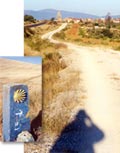 Typical "shell" and “Santiago” points the way as Philippe enters the “meseta,” a challenging stretch along the second part of his journey. |
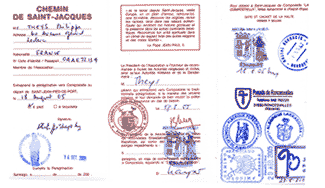 Credential document where I collected all the stamps confirming my stays at locations along the Way of Saint James. |
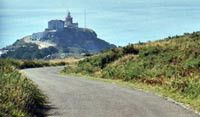 Cape Finisterra, the end of Europe. |
The next morning I was walking under the gate of Spain, a monument at the exit of the last French village that I passed through. Unlike the previous year, I encounter a large number of pilgrims. The evening before, I collected a new Credential document that would collect all the stamps confirming my stays at locations along the way. My previous document is practically filled up.
The second walking day was definitely very steep. We started at an elevation of 320 m and then crossed the pass of Lepoeder over the Pyrenees at an altitude of 1410 m. The pass marks the border with Spain. There are no customs or security agents. Europe is seamless, and even the local patois (Basque) is the same on both sides of the border.
 The cathedral of Santiago. |
The third day brought me to Pamplona, after a 40 km stretch. Pamplona is known for its feria, when bulls are sent stampeding through the city. After Pamplona, I crossed another chain of mountains, then two days later another one, la sierra de Cerniz. This itinerary is quite different from the rather flat path followed in France. Now, most encounters are handled in Spanish, with some exceptions when speaking with Hungarians, Canadians and Irish. Another substantial difference is the crossing of large cities – Logrono, Burgos - with interminable industrial areas, the Poligonos Industriales. Some pilgrims – considering that these suburbs poorly fit with a Middle age tradition – take buses to avoid them. I could not resolve myself to do the same.
After ten days, completely unannounced a blister attacked my left heel. In addition, along the long, monotonous plateau called Meseta, small gnats harassed me. In El Burgo Ranero, a small village a few miles from Sahagun, I became aware of the fact that there were only 360 km left to reach Santiago. I have been walking without interruption for 13 days. The following day, in Leon, I met an Italian pilgrim. He had the impossible objective of reaching Astorga, 48 km away, the same day. We managed to do it.
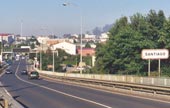 Entrance of the town of Santiago. |
 Bridge in Punta la Reina. |
More and more pilgrims were now on the road. Generally, I passed them, but as we climbed the Cebreiro mountain in the rain, a fairly old, but physically in good shape chap, passed me. He was almost running as the climb took us from 500 m to 1400 m. We reached the pass, the border of the Galicia province, whose capital is Santiago, 151.5 km away, in pouring rain. At the San Roque pass, a few km further, I sympathized with the pilgrim represented by a statue. He is fighting against wind and rain. Except for the red color of my poncho we looked very much the same.
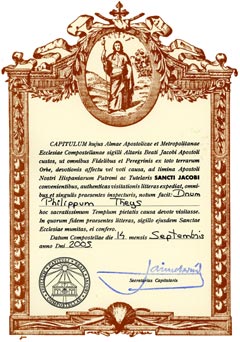 Philippe's diploma, received at end of his pilgrimage along the Way of Saint James. |
Soon, I find myself in the town of Sarria. A lot of pilgrims start from this place, because, if you can prove that you walked 100 km to Santiago, you are eligible for the Compostela. The Way of St James was now filling with a continuous stream of walkers.
Two days later, as my daily average distance had become the equivalent of a marathon, I reached the sign showing the entrance of Santiago. A bridge over the freeway and many factories spoil the legendary landscape. This is a far cry from “falling on your knees and starting to sing,” the feeling that was felt by the pilgrims several centuries before. But, as I walked towards the center of the city, everything changed: the towers of the churches, the pilgrim gate, and then suddenly the vast esplanade where the cathedral sits with its unique style. I confess that a tear rolled on my cheek, and I could see that all of us pilgrims were going through the same emotion. More than 1600 km from Vezelay, I completed my quest.
Epilogue
In Santiago, I soon obtained my diploma, written in Latin, confirming my walk from France to Santiago. The following day, I took a bus to Finisterra, which literally means, land’s end. Tradition requires that pilgrims burn all their belongings and start anew. I contented myself to burn one sock – I could not imagine it was so difficult to do so. The next day I was flying to Paris, retracing in a couple of hours the distance that took me 52 days to walk.
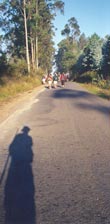 Compared to France, many more pilgrims could be found in Spain. |
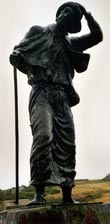 Statue depicting an old time pilgrim fighting in the rain near the pass of Cebreiro (at 1300 m). I really felt the same as it was pouring down that very day. |
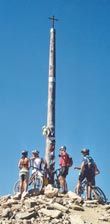 Cruz de Hierro (the Iron Cross). |
This content has been re-published with permission from SEED. Copyright © 2025 Schlumberger Excellence in Education Development (SEED), Inc.

